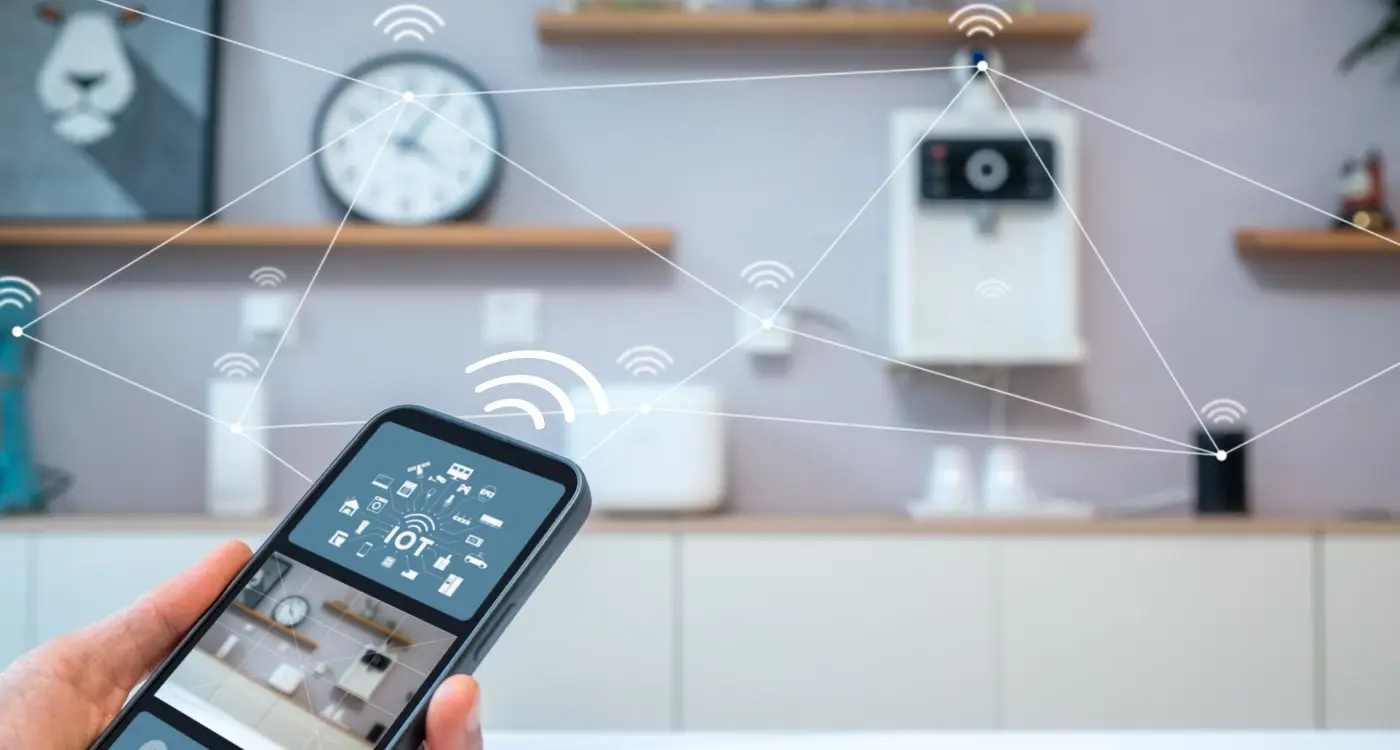How Do You Secure IoT Devices in Mobile App Integration?
A smart thermostat in a London office building starts sending heating commands at 3am during winter, pushing energy bills through the roof. The facilities manager discovers hackers accessed the device through a poorly secured mobile app that controlled the building's entire IoT network. What started as a convenience feature became a £50,000 problem—and that's just the heating bill, not counting the security breach investigation.
IoT security isn't just about protecting gadgets anymore; it's about safeguarding entire ecosystems where mobile apps serve as the gateway to our connected world. When you integrate IoT devices with mobile applications, you're creating entry points that hackers love to exploit. The problem is that many developers treat IoT security as an afterthought rather than a foundation.
Every connected device is a potential doorway into your network, and mobile apps are often holding the keys
This guide will walk you through the practical steps needed to secure IoT devices when integrating them with mobile apps. We'll cover everything from understanding common vulnerabilities to implementing robust authentication systems. You don't need to be a cybersecurity expert to follow along—just someone who wants to build secure, reliable IoT solutions that won't come back to haunt you later.
Understanding IoT Device Vulnerabilities
IoT devices are everywhere these days—smart thermostats, fitness trackers, connected door locks, you name it. They make our lives easier, but here's the thing: they also create new ways for hackers to get into our systems. Most IoT devices are built to be cheap and simple, which means security often gets pushed to the bottom of the priority list.
The biggest problem? Many IoT devices come with default passwords that users never change. I've seen countless devices still running on "admin/admin" or "123456" months after installation. It's like leaving your front door wide open with a sign saying "come on in!"
Common IoT Security Weaknesses
These devices often lack proper encryption, send data in plain text, and rarely receive security updates. Some don't even have the ability to be updated at all—once they're manufactured, that's it. When you connect these vulnerable devices to your mobile app, you're potentially opening up your entire system to attack.
- Weak or unchangeable default passwords
- Missing or poor encryption protocols
- Infrequent or non-existent software updates
- Insecure data transmission methods
- Limited processing power for robust security measures
The key is identifying these vulnerabilities early in your development process. You can't fix what you don't know is broken, and with IoT app development, what you don't know really can hurt you.
Authentication and Access Control
Getting authentication right is one of those things that can make or break your IoT security strategy. When you're integrating IoT devices with mobile apps, you're basically creating multiple entry points into your system—and each one needs proper security checks.
Think of authentication as your digital bouncer. Every device and user needs to prove who they are before they get access. This means implementing strong password policies, multi-factor authentication, and regular credential updates. I've seen too many projects where developers use default passwords or simple PIN codes; that's like leaving your front door wide open.
Device-Level Security
Your IoT devices need unique identities—not just serial numbers, but proper cryptographic certificates that can't be easily copied or faked. Each device should have its own authentication credentials that get verified every time it connects to your mobile app or cloud services.
Always implement role-based access control. Not every user needs admin privileges, and not every device needs access to all system functions. Limit permissions to what's actually needed.
User Management
On the mobile app side, implement proper session management with automatic timeouts. Users shouldn't stay logged in indefinitely, especially when dealing with sensitive IoT data. Regular authentication checks help prevent unauthorised access if a device gets lost or stolen.
Encryption Methods for Data Protection
When data travels between your mobile app and IoT devices, it's like sending a secret message that needs protection. Encryption scrambles this information so only authorised devices can read it—think of it as turning readable text into a jumbled code that makes no sense to outsiders.
The most common method we use is AES encryption, which stands for Advanced Encryption Standard. It's been around for decades and remains one of the strongest options available. AES comes in different key sizes: 128-bit, 192-bit, and 256-bit. The larger the number, the stronger the protection, but 128-bit is usually sufficient for most mobile IoT applications.
Transport Layer Security
TLS (Transport Layer Security) handles encryption whilst data moves between devices. Most developers implement TLS 1.2 or 1.3, which automatically handles the encryption process. You don't need to build your own encryption—TLS does the heavy lifting.
End-to-End Encryption Options
For sensitive applications, consider end-to-end encryption where data stays encrypted even when passing through servers. Here are the main approaches:
- Symmetric encryption using shared keys between app and device
- Asymmetric encryption with public/private key pairs
- Hybrid systems combining both methods for optimal performance
- Hardware-based encryption using device security chips
Remember that stronger encryption requires more processing power, which can drain battery life on IoT devices. Finding the right balance between security and performance is key to ensuring your app remains secure.
Network Security Protocols
When your IoT devices start chatting with your mobile app, they need a secure way to talk to each other. Think of network security protocols as the rules that keep these conversations private and safe from unwanted listeners.
The most common protocol you'll encounter is TLS (Transport Layer Security), which creates an encrypted tunnel between your IoT device and your app. Every piece of data that travels through this tunnel gets scrambled so thoroughly that even if someone intercepts it, they can't make sense of what they've captured. Most modern IoT devices support TLS 1.2 or higher—anything older than that is asking for trouble.
Choosing the Right Protocol
For lightweight IoT devices with limited processing power, you might need to consider protocols like DTLS (Datagram Transport Layer Security) or CoAP (Constrained Application Protocol). These are designed specifically for connected devices that can't handle the overhead of traditional security protocols.
Network security isn't just about encryption—it's about creating multiple layers of protection that work together to keep your IoT ecosystem safe
Don't forget about certificate validation either. Your mobile app should always verify that it's talking to the right device by checking digital certificates. Without this step, you're basically accepting calls from strangers who claim to be your IoT device.
API Security Best Practices
When your mobile app talks to IoT devices, it uses something called APIs—think of them as messengers that carry information back and forth. These messengers need proper protection because they're handling sensitive data from your smart home gadgets, wearable devices, or industrial sensors.
The first rule is simple: always use HTTPS instead of HTTP. This scrambles your data as it travels, making it unreadable to anyone trying to snoop. I've seen too many apps skip this basic step and regret it later when data gets intercepted.
Token-Based Authentication
Rather than sending passwords with every request, use tokens that expire after a set time. OAuth 2.0 is your best friend here—it creates temporary passes that work for specific tasks only. If someone steals a token, it won't work forever, and they can't access everything.
Rate Limiting and Input Validation
Set limits on how many requests your API accepts per minute. This stops attackers from overwhelming your system with fake requests. Always check that incoming data looks right too—if someone sends weird characters or oversized files, reject them straight away.
Keep your API documentation private and only share what developers absolutely need to know. The less information available publicly, the harder it becomes for bad actors to find weak spots in your API security.
User Privacy and Data Management
When you're connecting IoT devices to mobile apps, you're handling some pretty sensitive stuff—and I mean that literally. Smart thermostats know when people are home, fitness trackers monitor heart rates, and smart speakers listen to conversations. All this data flows through your app, which makes you responsible for protecting it properly.
The golden rule here is simple: collect only what you absolutely need. I've seen too many apps hoover up every piece of data they can get their hands on, thinking they might use it later. Don't do this. Be specific about what data you're collecting and why; users are getting savvy about this stuff and they'll notice if you're being greedy with their information.
Data Minimisation and Storage
Start by implementing data minimisation—only request permissions for IoT device data that's directly related to your app's core functionality. Store personal data locally on the device when possible, rather than sending everything to your servers. When you do need cloud storage for your app data, encrypt data both in transit and at rest.
Always provide users with clear, granular controls over what data they share. Let them turn off specific IoT device integrations without breaking your entire app—they'll trust you more for giving them that choice.
Consent and Transparency
Make your privacy policy readable and specific to IoT data collection. Users should understand exactly which devices you're accessing, what data you're collecting, and how you're using it. Regular data audits help you stay compliant with privacy regulations whilst keeping your IoT security practices sharp.
Security Testing and Monitoring
Testing your IoT security isn't something you do once and forget about—it's an ongoing process that needs constant attention. I've seen too many apps get compromised months after launch because developers thought their initial security measures were enough. They weren't.
Start with penetration testing, which basically means trying to hack your own system before the bad guys do. You'll want to test every connection point between your mobile app and IoT devices. This includes checking if someone can intercept messages, access data they shouldn't, or take control of devices.
Key Areas to Monitor Continuously
- Unusual data traffic patterns between devices
- Failed authentication attempts
- Unexpected device behaviour or commands
- Network connection anomalies
- Data encryption failures
Set up automated monitoring tools that alert you when something looks suspicious. These systems can spot problems faster than humans ever could—and they don't need sleep! Log everything that happens between your app and IoT devices, but make sure you're not storing sensitive user data in those logs.
Regular Security Audits
Schedule security reviews every few months. Technology changes fast, and new vulnerabilities appear regularly. What was secure six months ago might not be secure today. Keep your security certificates updated, patch any discovered vulnerabilities quickly, and test your backup systems regularly. Remember, good security monitoring means staying one step ahead of potential threats.
Conclusion
After working on countless mobile app integrations with IoT devices over the years, I can tell you that security isn't something you can bolt on at the end—it needs to be baked into every decision you make. From the moment you start planning your app's architecture to the day you push it live, IoT security should be at the forefront of your thinking.
The truth is, securing IoT devices in mobile app integration isn't rocket science, but it does require discipline. You need robust authentication systems that verify both users and devices; you need encryption that protects data whether it's sitting still or moving between systems; you need network protocols that create secure communication channels. Most importantly, you need to treat security as an ongoing process, not a one-time checkbox.
What I've seen time and again is that the teams who get this right are the ones who take a layered approach. They don't rely on just one security measure—they combine multiple strategies to create a defence system that's much harder to breach. Device security starts with understanding your vulnerabilities and then systematically addressing each one through proper implementation and continuous monitoring.
Your users trust you with their data and their connected devices. Don't take that responsibility lightly.
Share this
Subscribe To Our Learning Centre
You May Also Like
These Related Guides

Which Encryption Methods Work Best for IoT App Integration?

What Are the Best Practices for IoT Device Authentication?



